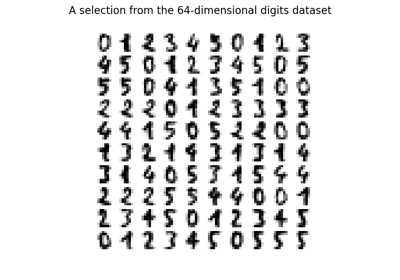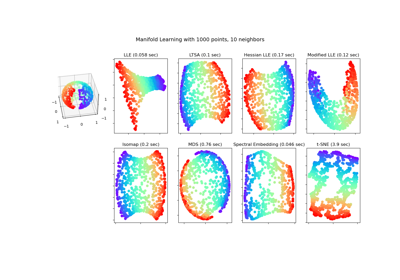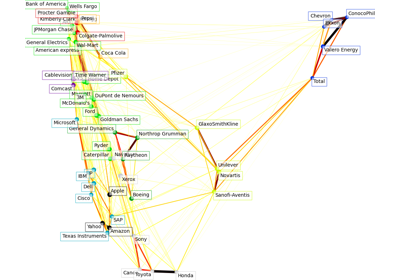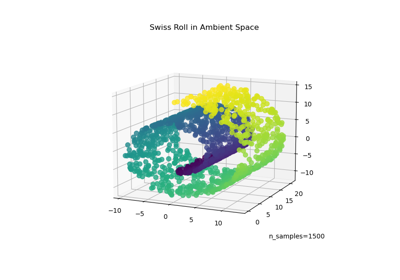注意
转到末尾以下载完整示例代码或通过 JupyterLite 或 Binder 在浏览器中运行此示例。
流形学习方法比较#
使用各种流形学习方法对 S 曲线数据集进行降维的演示。
有关这些算法的讨论和比较,请参阅流形模块页面
对于类似的示例,其中方法应用于球体数据集,请参阅切断球体上的流形学习方法
请注意,MDS 的目的是找到数据的低维表示(此处为 2D),其中距离与原始高维空间中的距离良好匹配,与其他流形学习算法不同,它不寻求数据在低维空间中的各向同性表示。
# Authors: The scikit-learn developers
# SPDX-License-Identifier: BSD-3-Clause
数据集准备#
我们首先生成 S 曲线数据集。
import matplotlib.pyplot as plt
# unused but required import for doing 3d projections with matplotlib < 3.2
import mpl_toolkits.mplot3d # noqa: F401
from matplotlib import ticker
from sklearn import datasets, manifold
n_samples = 1500
S_points, S_color = datasets.make_s_curve(n_samples, random_state=0)
让我们看看原始数据。还定义了一些辅助函数,我们将在后面使用它们。
def plot_3d(points, points_color, title):
x, y, z = points.T
fig, ax = plt.subplots(
figsize=(6, 6),
facecolor="white",
tight_layout=True,
subplot_kw={"projection": "3d"},
)
fig.suptitle(title, size=16)
col = ax.scatter(x, y, z, c=points_color, s=50, alpha=0.8)
ax.view_init(azim=-60, elev=9)
ax.xaxis.set_major_locator(ticker.MultipleLocator(1))
ax.yaxis.set_major_locator(ticker.MultipleLocator(1))
ax.zaxis.set_major_locator(ticker.MultipleLocator(1))
fig.colorbar(col, ax=ax, orientation="horizontal", shrink=0.6, aspect=60, pad=0.01)
plt.show()
def plot_2d(points, points_color, title):
fig, ax = plt.subplots(figsize=(3, 3), facecolor="white", constrained_layout=True)
fig.suptitle(title, size=16)
add_2d_scatter(ax, points, points_color)
plt.show()
def add_2d_scatter(ax, points, points_color, title=None):
x, y = points.T
ax.scatter(x, y, c=points_color, s=50, alpha=0.8)
ax.set_title(title)
ax.xaxis.set_major_formatter(ticker.NullFormatter())
ax.yaxis.set_major_formatter(ticker.NullFormatter())
plot_3d(S_points, S_color, "Original S-curve samples")
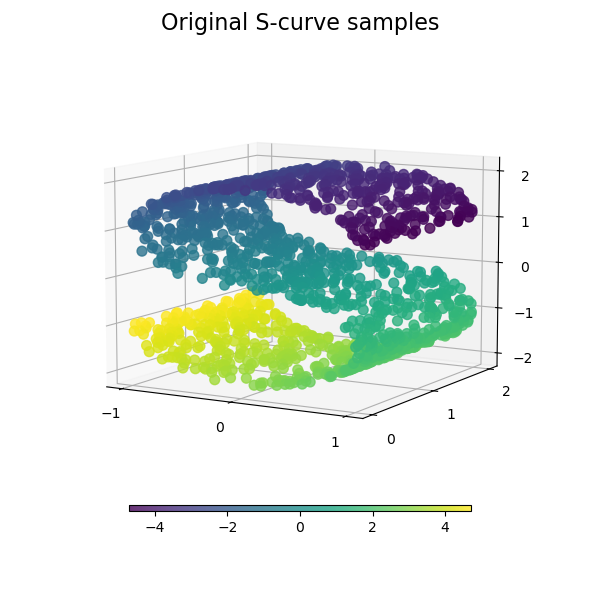
定义流形学习算法#
流形学习是一种非线性降维方法。用于此任务的算法基于这样一个想法:许多数据集的维度只是人为地高。
在用户指南中阅读更多内容。
n_neighbors = 12 # neighborhood which is used to recover the locally linear structure
n_components = 2 # number of coordinates for the manifold
局部线性嵌入#
局部线性嵌入 (LLE) 可以被认为是一系列局部主成分分析,这些分析被全局比较以找到最佳非线性嵌入。在用户指南中阅读更多内容。
params = {
"n_neighbors": n_neighbors,
"n_components": n_components,
"eigen_solver": "auto",
"random_state": 0,
}
lle_standard = manifold.LocallyLinearEmbedding(method="standard", **params)
S_standard = lle_standard.fit_transform(S_points)
lle_ltsa = manifold.LocallyLinearEmbedding(method="ltsa", **params)
S_ltsa = lle_ltsa.fit_transform(S_points)
lle_hessian = manifold.LocallyLinearEmbedding(method="hessian", **params)
S_hessian = lle_hessian.fit_transform(S_points)
lle_mod = manifold.LocallyLinearEmbedding(method="modified", **params)
S_mod = lle_mod.fit_transform(S_points)
fig, axs = plt.subplots(
nrows=2, ncols=2, figsize=(7, 7), facecolor="white", constrained_layout=True
)
fig.suptitle("Locally Linear Embeddings", size=16)
lle_methods = [
("Standard locally linear embedding", S_standard),
("Local tangent space alignment", S_ltsa),
("Hessian eigenmap", S_hessian),
("Modified locally linear embedding", S_mod),
]
for ax, method in zip(axs.flat, lle_methods):
name, points = method
add_2d_scatter(ax, points, S_color, name)
plt.show()
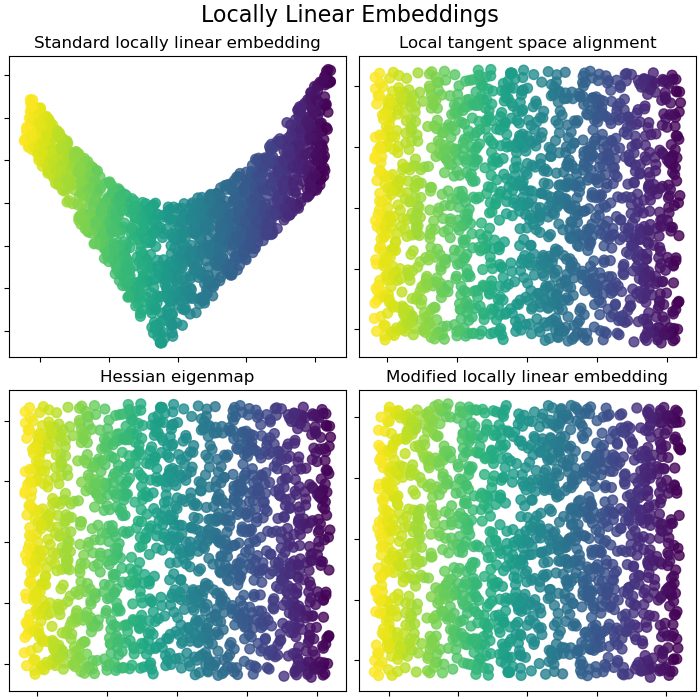
Isomap 嵌入#
通过等距映射进行非线性降维。Isomap 寻找一个低维嵌入,它保持所有点之间的测地距离。在用户指南中阅读更多内容。
isomap = manifold.Isomap(n_neighbors=n_neighbors, n_components=n_components, p=1)
S_isomap = isomap.fit_transform(S_points)
plot_2d(S_isomap, S_color, "Isomap Embedding")
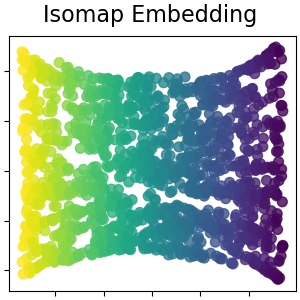
多维缩放#
多维缩放 (MDS) 寻找数据的低维表示,其中距离与原始高维空间中的距离良好匹配。在用户指南中阅读更多内容。
md_scaling = manifold.MDS(
n_components=n_components,
max_iter=50,
n_init=1,
random_state=0,
init="classical_mds",
normalized_stress=False,
)
S_scaling_metric = md_scaling.fit_transform(S_points)
md_scaling_nonmetric = manifold.MDS(
n_components=n_components,
max_iter=50,
n_init=1,
random_state=0,
normalized_stress=False,
metric_mds=False,
init="classical_mds",
)
S_scaling_nonmetric = md_scaling_nonmetric.fit_transform(S_points)
md_scaling_classical = manifold.ClassicalMDS(n_components=n_components)
S_scaling_classical = md_scaling_classical.fit_transform(S_points)
fig, axs = plt.subplots(
nrows=1, ncols=3, figsize=(7, 3.5), facecolor="white", constrained_layout=True
)
fig.suptitle("Multidimensional scaling", size=16)
mds_methods = [
("Metric MDS", S_scaling_metric),
("Non-metric MDS", S_scaling_nonmetric),
("Classical MDS", S_scaling_classical),
]
for ax, method in zip(axs.flat, mds_methods):
name, points = method
add_2d_scatter(ax, points, S_color, name)
plt.show()
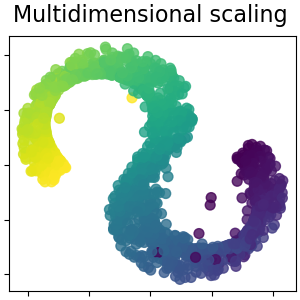
用于非线性降维的谱嵌入#
此实现使用拉普拉斯特征图,它使用图拉普拉斯的谱分解来查找数据的低维表示。在用户指南中阅读更多内容。
spectral = manifold.SpectralEmbedding(
n_components=n_components, n_neighbors=n_neighbors, random_state=42
)
S_spectral = spectral.fit_transform(S_points)
plot_2d(S_spectral, S_color, "Spectral Embedding")
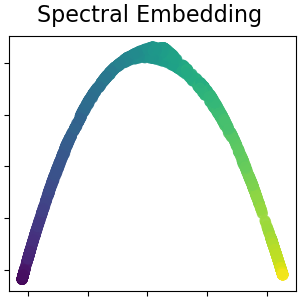
T 分布随机邻居嵌入#
它将数据点之间的相似性转换为联合概率,并试图最小化低维嵌入的联合概率与高维数据之间的 Kullback-Leibler 散度。t-SNE 的成本函数不是凸函数,即使用不同的初始化,我们可以得到不同的结果。在用户指南中阅读更多内容。
t_sne = manifold.TSNE(
n_components=n_components,
perplexity=30,
init="random",
max_iter=250,
random_state=0,
)
S_t_sne = t_sne.fit_transform(S_points)
plot_2d(S_t_sne, S_color, "T-distributed Stochastic \n Neighbor Embedding")
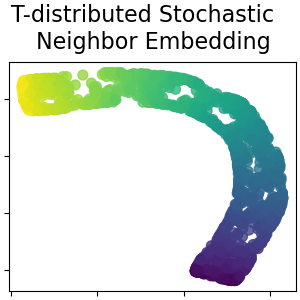
脚本总运行时间: (0 分钟 20.244 秒)
相关示例
